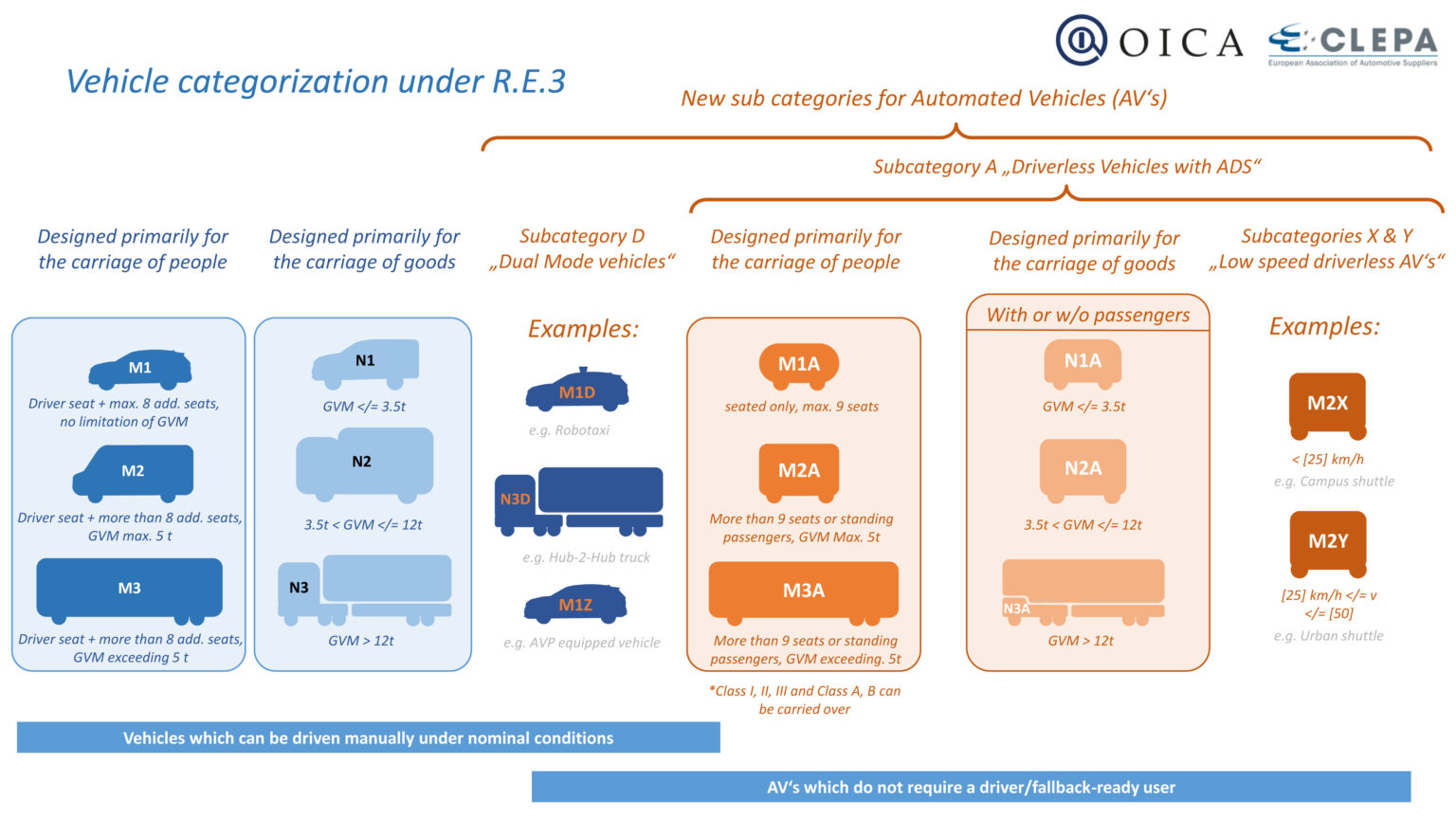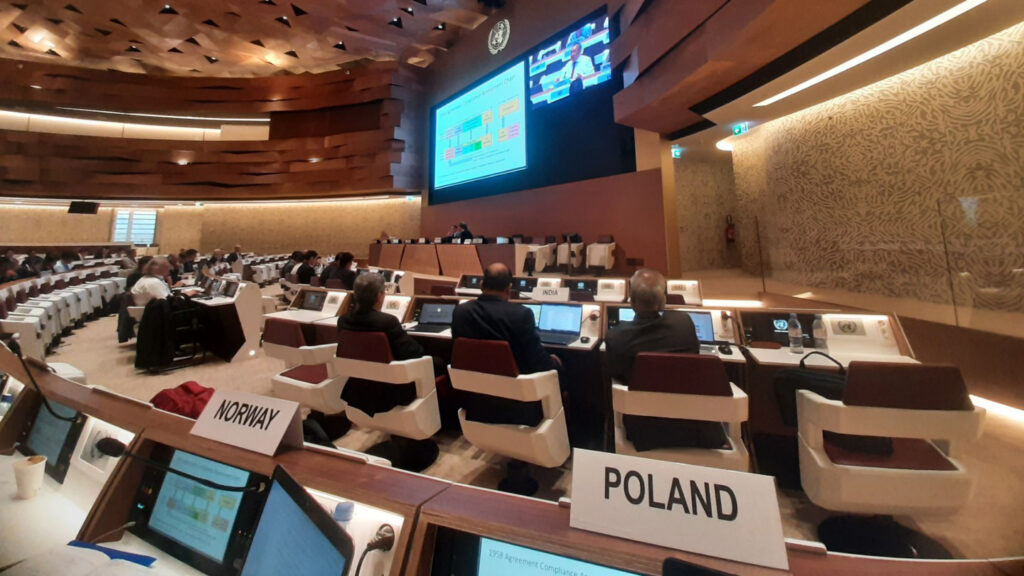Blog
Proposal to introduce new subcategories for vehicles equipped with Automated Driving Systems
The 17th Session of the Working Party on Automated/Autonomous and Connected Vehicles (GRVA) was held from September 25 to 29, 2023 at the Palace of Nations in Geneva. The event was attended by, among others: Dr. Eng. Artur Gołowicz, Head of the Vehicle Dynamic Testing Laboratory of the Vehicle Type-Approval & Testing Department at the Motor Transport Institute – an expert appointed by the Transportation Technical Supervision and representative of the Connected and Autonomous Vehicles Competence Centre (CK:PAP). The expert group established within GRVA falls under WP.29 – World Forum for Harmonization of Vehicles Regulations.
During the September meeting, the topics discussed included: issues related to the implementation of regulations regarding the type-approval and testing of automated driving systems. Due to the development of such driving systems, a new approach to vehicle categorization is required. During the GRVA meeting, the need to introduce changes in the categorization of vehicles equipped with ADS (Automated Driving Systems) was discussed. Vehicle categories are defined in R.E.3 – Consolidated Resolution on the Construction of Vehicles, which is applied to Member States under the so-called 1958 Agreement and in S.R.1. – Special Resolution adopted by the Executive Committee (AC.3) of the 1998 Agreement. At the current level of work, the aim is to unify the categorization of vehicles under R.E.3 and S.R.1. For this purpose, experts from the European Association of Automotive Suppliers (CLEPA) and the International Organization of Motor Vehicle Manufacturers (OICA) submitted the formal document ECE/TRANS/WP.29/GRVA/2023/28 – Proposal for new vehicle subcategories for vehicles equipped with automated driving systems.
After analyzing the applicable regulations, the proposal was positively received by experts. A need for a new approach was identified to address the different use cases of ADS-equipped vehicles. The proposed categorization concept includes a balanced approach between the number of AV categories and the requirements specific to ADS use cases in each individual legal act, and maintaining the current logic (basic vehicle categorization). The new concept is intended to enable easy application of the planned changes to the existing WVTA (Whole Vehicle Type Approval) framework.
The concept of introducing changes to R.E.3 in the form of new vehicle subcategories is presented in the figure below.

Source: GRVA-17-37, Informal document prepared by experts from CLEPA and OICA for the 17th GRVA Session, September 25-29, 2023.
The most important changes:
- paragraph 2.10 has been added, which includes the proposed definition of a new vehicle subcategory: “Dual-mode vehicles with Automated Driving Systems”. The definition defines dual-mode vehicles as “vehicles of category M or N [or L] which can be driven manually and which are equipped with an Automated Driving System (ADS) not designed to issue Transition Demands/ Transition Of Control (allowing the vehicle to be driven in an automated mode). Such ADS would not require an interaction by a driver (i.e. a fallback-ready user) to take back manual control”.It is also proposed to categorize vehicles operating in dual-mode by dividing them into two subcategories depending on the maximum speed at which ADS is to operate. In cases where ADS enables different driving modes, e.g. low and high speed ADS driving mode, the function with the highest maximum speed determines the maximum speed for the ADS driving mode to be used and is therefore taken into account in the categorization of dual-mode vehicles. Depending on the maximum operating speed of the vehicle using ADS, it is proposed to be divided into:
• subcategory D vehicles, i.e. dual-mode vehicles having a maximum operational speed of the ADS exceeding [25] km/h.,
• subcategory Z vehicles, i.e. dual-mode vehicles having a maximum operational speed of the ADS not exceeding [25] km/h.
It is assumed that the markings can be combined. Categories M and N may be combined with subcategories D or Z. For example, a vehicle of category M1 which is suitable for use in two driving modes and whose maximum driving speed using ADS exceeds 25 km/h should be marked as M1D. - paragraph 2.11 was added, which proposed a new subcategory of vehicles: A – “Driverless vehicles with Automated Driving Systems”. It also defines “driverless vehicles” as “vehicles of category M or N [or L] which are equipped with an ADS and [cannot be driven manually under nominal conditions/are not falling under the definition of dual mode vehicles]. Such an ADS allows the vehicle to be driven in an automated mode, it is not designed to issue Transition Demands/ Transition Of Control and it would not require an interaction by a driver (i.e. a fallback-ready user) to take back manual control”.
It is assumed that categories M and N may be combined with subcategory A. For example, a vehicle of category M1, which is considered an autonomous vehicle, should be marked as M1A. - paragraph 2.12 was added, which proposed a new subcategory of vehicles – “Low-speed driverless vehicles with Automated Driving Systems” and the division into:
• subcategory X vehicles, i.e. vehicles belonging to subcategory A, but having a maximum design speed not exceeding [25] km/h,
• subcategory Y vehicles, i.e. vehicles belonging to subcategory A, having a maximum design speed exceeding [25] km/h but not exceeding [50] km/h.
Categories M and N may be combined with subcategory X or Y. For example, a vehicle of category M1, considered to be a low-speed vehicle of subcategory Y, should be marked as M1Y.
In order to adopt changes to R.E.3, the document must be accepted by all working groups within WP.29. For this purpose, it was also presented at the 126th Session on General Safety Provisions (GRSG), which took place on October 10-13, 2023, in which participated (as an expert appointed by the Transportation Technical Supervision), a representative of CK:PAP, Dr. Eng. Artur Golowicz.
Source:
ECE/TRANS/WP.29/GRVA/2023/28 – Proposal for new vehicle subcategories for vehicles equipped with automated driving systems).
GRVA-17-37, Informal Document submitted by the experts from CLEPA and OICA for 17th GRVA, 25-29 September 2023.
ECE/TRANS/WP.29/78/Rev.7 – R.E.3 – Consolidated Resolution on the Construction of Vehicles).
TRANS/WP.29/1045 – S.R.1. – Special Resolution adopted by the Executive Committee (AC.3) of the 1998 Agreement.
United Nations Economic Commission for Europe (UNECE) – https://unece.org/


